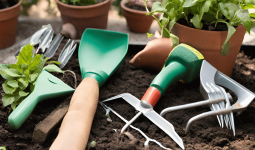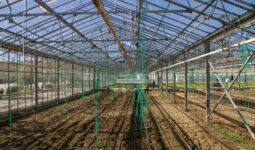If you’re passionate about gardening and want to extend your growing season or create the perfect environment for your plants, a portable greenhouse might be just what you need.
These versatile structures provide a controlled and protected space for your plants to thrive.
Let’s explore what portable greenhouses are all about and the benefits they offer.
Introduction to Portable Greenhouses
A portable greenhouse is a smaller, more flexible version of a traditional greenhouse.
It consists of a lightweight frame made from materials like aluminum or steel, covered with a transparent plastic or polycarbonate material.
This covering allows sunlight to enter the greenhouse while trapping heat inside, creating a warm and nurturing environment for your plants.
Portable greenhouses come in various sizes and designs, making them suitable for gardens of all sizes.
Whether you have limited space or frequently change your garden layout, a portable greenhouse offers the flexibility to adapt to your needs. You can easily assemble, disassemble, and move these structures as desired.
This mobility allows you to position your greenhouse in the optimal location to maximize sunlight exposure and protect your plants from harsh weather conditions.
Benefits of Using a Portable Greenhouse
Using a portable greenhouse offers several advantages for your gardening endeavors.
Here are some key benefits:
- Extended Growing Season: With a portable greenhouse, you can start planting earlier in the spring and continue growing plants later into the fall. The controlled environment protects your plants from frost, cold temperatures, and other weather extremes, allowing you to enjoy fresh produce or vibrant flowers for an extended period.
- Protection from Pests and Diseases: A portable greenhouse acts as a physical barrier, preventing pests like insects and animals from damaging your plants. Additionally, the enclosed space helps to keep diseases at bay by limiting the contact between your plants and external pathogens.
- Customizable Environment: Portable greenhouses allow you to control various environmental factors essential for plant growth, such as temperature, humidity, and ventilation. You have the flexibility to adjust these conditions based on the specific needs of your plants, ensuring optimal growing conditions.
- Versatility: Whether you’re growing seedlings, nurturing delicate plants, or overwintering potted plants, a portable greenhouse can accommodate a wide range of plant types and sizes. You have the freedom to experiment with different gardening techniques and create a customized space that suits your specific gardening goals.
- Cost-Effective: Portable greenhouses are generally more affordable than permanent structures. They provide an economical solution for those who want to experience the benefits of a greenhouse without investing in a larger, more permanent setup.
By harnessing the power of a portable greenhouse, you can unleash your gardening potential and create an ideal environment for your plants to thrive.
In the following sections, we will explore how to set up and maximize the growth of your plants in a portable greenhouse.
Stay tuned to discover the tips and techniques that will help you make the most of your greenhouse gardening experience.
Setting Up Your Portable Greenhouse
To make the most of your portable greenhouse, properly set it up for optimal plant growth.
This section will guide you through the process of choosing the right location, preparing the ground, and assembling the greenhouse.
Choosing the Right Location
Selecting the right location for your portable greenhouse plays a vital role in the success of your plants.
Here are a few factors to consider:
- Sunlight: Choose a spot that receives ample sunlight throughout the day. Most plants require at least 6 hours of direct sunlight for healthy growth.
- Access to Water: Ensure that your greenhouse is located near a water source for convenient watering. This will make it easier to maintain the required moisture levels for your plants.
- Protection from Harsh Elements: Avoid areas prone to strong winds, as they can damage the structure of the greenhouse. Additionally, consider any potential risks from nearby trees or structures that may block sunlight or cause damage.
Preparing the Ground
Before setting up your portable greenhouse, it’s essential to prepare the ground to create a suitable foundation for your plants.
Follow these steps:
- Clear the Area: Remove any weeds, rocks, or debris from the ground where the greenhouse will be placed. This ensures a clean and level surface for your plants.
- Level the Ground: Use a garden rake or shovel to level the ground. This will help prevent water from pooling in one area and ensure even distribution throughout the greenhouse.
- Consider Drainage: If your greenhouse will be placed on a solid surface like concrete, create a drainage system using gravel or small holes to allow excess water to escape.
Assembling the Greenhouse
Assembling your portable greenhouse may vary depending on the specific model and manufacturer.
It’s crucial to follow the instructions provided with your greenhouse carefully.
Here are some general tips to keep in mind:
- Read the Instructions: Before starting the assembly process, thoroughly read the instructions provided with your greenhouse. Familiarize yourself with the steps and ensure you have all the necessary tools and materials.
- Enlist Help if Needed: Some greenhouse models may require more than one person for assembly. If necessary, ask a friend or family member to assist you.
- Take Your Time: Patience is key when assembling a greenhouse. Follow each step carefully and avoid rushing. This will help ensure the structure is sturdy and secure.
- Secure the Greenhouse: Once assembled, make sure to secure the greenhouse to the ground or anchor it properly. This will prevent it from being damaged or blown away during strong winds.
By correctly choosing the right location, preparing the ground, and assembling your portable greenhouse, you’ll create an ideal environment for your plants to thrive.
The next section will explore maximizing plant growth by controlling temperature, providing adequate light, and managing watering and nutrients.
Maximizing Plant Growth
To get the most out of your portable greenhouse, it’s important to focus on maximizing plant growth.
By controlling temperature and humidity, providing adequate light, and ensuring proper watering and nutrient management, you can create an optimal environment for your plants to thrive.
Controlling Temperature and Humidity
Temperature and humidity are crucial factors in plant growth. In your portable greenhouse, it’s important to monitor and regulate these variables to create an environment that mimics the ideal conditions for your plants.
- Temperature: Different plants have different temperature preferences. Use a thermometer to monitor the temperature inside the greenhouse and adjust the ventilation or heating accordingly. Check our article on how to heat a greenhouse or how to cool a greenhouse for tips on maintaining the ideal temperature.
- Humidity: Plants have varying humidity requirements, and it’s important to provide the right level of moisture in the air. Use a hygrometer to measure the humidity levels in the greenhouse. Consider using a humidifier or misting the plants if the humidity is too low. On the other hand, if the humidity is too high, ensure proper ventilation to prevent mold and fungal growth.
Providing Adequate Light
Light is essential for photosynthesis, the process by which plants convert light energy into food.
In a portable greenhouse, it’s important to ensure that your plants receive adequate light for healthy growth.
- Natural Light: Place your portable greenhouse in a location that receives ample sunlight throughout the day. Orient it to maximize exposure to the sun’s rays. Use our article on what is an indoor greenhouse called for information on alternatives if natural light is limited.
- Artificial Light: If natural light is insufficient or limited, you can supplement it with artificial lighting. LED grow lights or fluorescent lights are popular options for providing the right spectrum of light for plant growth. Position the lights at an appropriate distance from the plants to avoid burning or stunting their growth.
Watering and Nutrient Management
Proper watering and nutrient management are crucial for plant health and growth.
Different plants have varying water and nutrient requirements, so it’s important to be mindful of their specific needs.
- Watering: Monitor the soil’s moisture levels regularly and water the plants accordingly. Avoid overwatering, as it can lead to root rot and other issues. Use our article on how to water plants for general guidelines on proper watering techniques.
- Nutrients: Provide your plants with the necessary nutrients for healthy growth. Use a balanced fertilizer or organic compost to replenish the nutrients in the soil. Follow the recommended guidelines for your growing plants to avoid over- or under-fertilizing. Consider conducting soil tests periodically to assess nutrient levels and make adjustments as needed.
By focusing on temperature and humidity control, providing adequate light, and ensuring proper watering and nutrient management, you can create an ideal environment for your plants to thrive in your portable greenhouse.
Remember to monitor the conditions regularly and make necessary adjustments to maximize your plants’ growth and health.
Seasonal Gardening in a Portable Greenhouse
Once you have set up your portable greenhouse, you can start enjoying the benefits of year-round gardening.
With a portable greenhouse, you have the flexibility to adjust the conditions inside to suit different seasons and plant requirements.
Let’s explore how you can make the most of your portable greenhouse throughout the seasons.
Spring Planting
Spring is an exciting time for gardeners as it marks the beginning of the growing season.
In your portable greenhouse, you can start sowing seeds or transplanting seedlings of vegetables, herbs, and flowers that thrive in spring.
Some popular options include tomatoes, peppers, lettuce, spinach, and marigolds.
Ensure that the temperature inside the greenhouse remains optimal for the plants by monitoring it regularly.
You can use a thermometer to track the temperature and make any necessary adjustments.
Adequate ventilation is essential during this time to prevent overheating.
Open windows or use fans to maintain proper air circulation. For more information on temperature control in greenhouses, check out our article on how to cool a greenhouse.
Summer Maintenance
During the summer months, the temperature inside a portable greenhouse can soar.
It’s important to take measures to protect your plants from excessive heat.
Provide shade by using a shade cloth or applying a reflective coating to the greenhouse cover.
Additionally, consider using an automatic watering system to ensure that your plants receive an adequate water supply, especially during hot and dry periods.
Continue to monitor the temperature and humidity levels inside the greenhouse.
If the heat becomes too intense, you may need to employ additional cooling methods, such as evaporative cooling or misting systems.
For more information on cooling techniques for greenhouses, refer to our article on how to cool a greenhouse.
Fall and Winter Considerations
As the weather starts to cool down, you can extend your growing season by planting cool-season crops in your portable greenhouse.
Vegetables like kale, broccoli, cabbage, and carrots can thrive during this time. It’s important to protect your plants from frost by insulating the greenhouse.
You can use frost blankets or add an extra layer of insulation to the greenhouse cover. For more tips on protecting your plants from frost, refer to our article on how to heat a greenhouse.
During winter, maintaining a consistent temperature and humidity level is crucial for the survival of your plants.
Consider using a heater or insulation to keep the temperature within the desired range.
Regularly check the moisture levels in the soil and adjust your watering schedule accordingly.
For more information on heating methods for greenhouses, refer to our article on how to heat a greenhouse.
By adapting your gardening practices to each season, you can maximize the potential of your portable greenhouse.
Whether it’s spring planting, summer maintenance, or fall and winter considerations, the controlled environment of your portable greenhouse allows you to enjoy gardening throughout the year.
Remember to consult our articles on what is a greenhouse and how does a greenhouse work for a better understanding of the concept and functionality of greenhouses.
Tips for Successful Portable Greenhouse Gardening
To ensure a successful gardening experience with your portable greenhouse, there are a few key tips to keep in mind.
By implementing effective pest and disease management, maintaining proper ventilation, and conducting regular maintenance and cleaning, you can create an optimal environment for your plants to thrive.
Pest and Disease Management
Pests and diseases can threaten your plants’ health, even within a controlled greenhouse environment.
It’s important to be proactive in preventing and managing these issues.
Here are some tips to help you:
- Monitor regularly: Regularly inspect your plants for any signs of pests or diseases. Look for unusual spots, discoloration, wilting, or the presence of insects.
- Practice good hygiene: Keep your greenhouse clean and tidy, removing any fallen leaves or debris that can harbor pests or promote disease.
- Isolate affected plants: If you notice any signs of pests or diseases, promptly isolate the affected plants to prevent the spread to others.
- Use organic pest control: Consider using organic pest control methods such as neem oil, insecticidal soaps, or beneficial insects to manage pests. Avoid harsh chemical pesticides that may harm beneficial insects or your plants.
- Research and consult: If you’re unsure about a specific pest or disease, research and consult with gardening experts or local agricultural extension services to identify the problem and find appropriate solutions.
Proper Ventilation
Maintaining proper ventilation within your portable greenhouse is crucial for the health and well-being of your plants.
Good airflow helps to regulate temperature, prevent excessive humidity, and reduce the risk of fungal diseases.
Here are some tips for ensuring proper ventilation:
- Windows and vents: Make use of the windows and vents in your portable greenhouse to allow fresh air to circulate. Open them during the day when the temperature is suitable and close them at night or during extreme weather conditions.
- Fans and exhaust systems: Consider installing fans or exhaust systems to enhance airflow within the greenhouse. This can help to prevent stagnant air and maintain a healthy environment for your plants.
- Strategic positioning: Be mindful of the positioning of your plants to avoid overcrowding. Adequate spacing allows for better air circulation and prevents the development of moisture-related issues.
- Air circulation: Use fans or natural air currents to encourage air movement within the greenhouse. This can be especially beneficial for plants that require gentle air circulation, such as delicate seedlings.
Regular Maintenance and Cleaning
Regular maintenance and cleaning of your portable greenhouse will help keep it in optimal condition and promote healthy plant growth.
Here are some maintenance tips to consider:
- Remove debris: Regularly remove fallen leaves, spent flowers, and any other organic debris from both inside and outside the greenhouse. This helps to prevent the buildup of pests and diseases.
- Sanitize tools and equipment: Clean and sanitize your gardening tools and equipment regularly to minimize the risk of spreading pests or diseases from one plant to another.
- Inspect and repair: Routinely inspect your greenhouse for any signs of wear, tear, or damage. Repair or replace any damaged parts to maintain structural integrity and prevent potential issues.
- Clean greenhouse surfaces: Clean the surfaces of your greenhouse, including the walls and windows, to allow maximum light transmission. This helps to optimize plant growth and prevent the buildup of dirt and dust.
By following these tips for successful portable greenhouse gardening, you can create a healthy and thriving environment for your plants.
Remember to be vigilant in pest and disease management, ensure proper ventilation, and conduct regular maintenance and cleaning.
With proper care, your portable greenhouse will be a haven for lush and vibrant plant growth.








